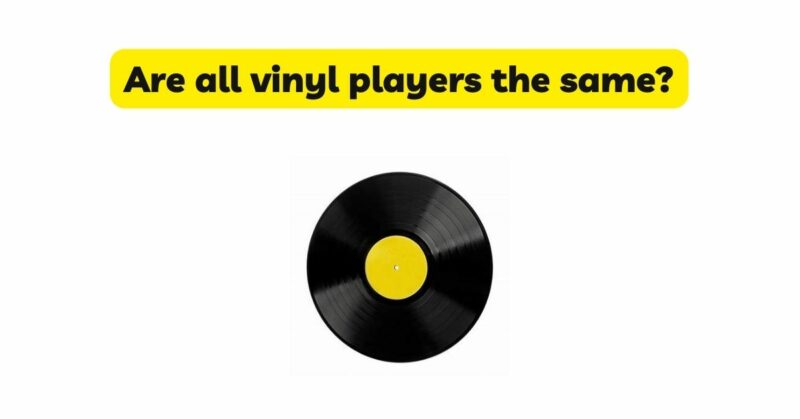As vinyl records continue to captivate music enthusiasts, the importance of a quality vinyl player cannot be understated. However, the market is flooded with a variety of options, leading to the question: Are all vinyl players the same? In this article, we will explore the factors that differentiate vinyl players, discussing the variations in quality, features, and performance that exist within the market.
Build Quality and Construction:
Vinyl players differ significantly in terms of build quality and construction. Higher-end turntables are often built with precision engineering and quality materials that minimize vibrations and resonance. These turntables feature robust plinths, heavy platters, and sturdy tonearms, resulting in better sound reproduction and increased durability. Conversely, lower-priced or entry-level turntables may compromise on components and construction quality to meet budget constraints.
Components and Features:
Vinyl players vary in terms of the components and features they offer. Some key components and features to consider include:
- Tonearm: The tonearm is responsible for holding the cartridge and stylus and tracking the grooves of the record. Higher-quality turntables typically feature adjustable tonearms with precise tracking force adjustment and anti-skate control, allowing for accurate and stable playback.
- Cartridge and Stylus: The cartridge and stylus are critical components that convert the physical movement of the stylus across the grooves into electrical signals. The quality of the cartridge and stylus can vary, with higher-end models offering better tracking ability and sound quality.
- Motor: The motor drives the rotation of the platter. High-quality turntables usually employ precision motors that provide consistent speed control and minimize speed irregularities, such as wow and flutter.
- Speed Control Mechanism: Turntables may utilize different mechanisms for speed control, such as belt drive, direct drive, or quartz-locked mechanisms. Each mechanism has its advantages and can impact the accuracy and stability of rotational speed.
- Phono Preamp: Some turntables have a built-in phono preamp, which amplifies the signal from the cartridge to line level, allowing direct connection to speakers or audio systems. Other turntables require an external phono preamp for proper signal amplification.
- USB Connectivity and Recording: Certain turntables offer USB connectivity, enabling direct connection to computers for digitizing vinyl records. This feature allows users to convert analog recordings into digital formats for convenient playback or archiving purposes.
Performance and Sound Quality:
Vinyl players can significantly differ in terms of performance and sound quality. Higher-end turntables often excel in areas such as:
- Tracking Ability: A good turntable should have excellent tracking ability, ensuring that the stylus stays in the groove without damaging the record. Precise tracking minimizes distortion and enhances the fidelity of the playback.
- Speed Accuracy: Accurate and stable rotational speed is crucial for faithful playback. Higher-end turntables typically provide better speed control, resulting in consistent playback and reduced pitch variations.
- Noise and Vibration Control: Well-built turntables incorporate features to minimize unwanted noise and vibrations, such as motor rumble or mechanical resonance. These features help maintain a clean and quiet listening experience.
- Sound Reproduction: Higher-quality turntables often offer better sound reproduction, capturing the nuances and details of the music with greater accuracy. This results in a more engaging and immersive listening experience.
Budget Considerations:
Budget plays a significant role in the selection of a vinyl player. While higher-quality turntables often come with a higher price tag, it is essential to strike a balance between budget considerations and expectations. Lower-priced turntables may offer adequate performance for casual listening but may lack the build quality and components necessary for optimal sound quality and long-term durability. It is advisable to allocate a reasonable budget to ensure a betterquality turntable that can deliver a more satisfying vinyl listening experience.
Conclusion:
In conclusion, not all vinyl players are the same. Variations in build quality, components, features, performance, and sound reproduction exist within the market. Higher-end turntables often feature superior build quality, precision components, advanced features, and better sound reproduction. Lower-priced or entry-level turntables may compromise on certain aspects to meet budget constraints. When selecting a vinyl player, it is crucial to consider factors such as build quality, components, performance, and your budget. Investing in a higher-quality turntable can provide a more satisfying and immersive vinyl listening experience, with better sound reproduction, reduced noise, and increased durability. By doing thorough research, considering your specific needs and preferences, and striking a balance between budget and quality, you can find a vinyl player that meets your expectations and allows you to fully enjoy the timeless charm of vinyl records.


